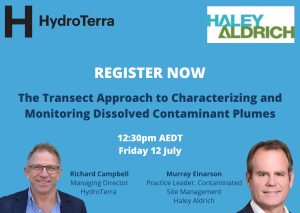Webinar tomorrow | Transect Approach to Characterizing and Monitoring Dissolved Contaminant Plumes
11 July 2024
 Tomorrow, we welcome Murray Einarson (Practice Leader, Contaminated Site Management) at Haley Aldrich for another exciting webinar!
Tomorrow, we welcome Murray Einarson (Practice Leader, Contaminated Site Management) at Haley Aldrich for another exciting webinar!
What will Murray cover?
Early conceptualizations of dissolved contaminant plumes assumed that hydrodynamic dispersion would cause the plumes to spread laterally and vertically along the flow path. The practice of monitoring groundwater contamination using spatially distributed, long-screened monitoring wells has perpetuated that belief. Groundwater field research has shown that hydrodynamic dispersion is much less extensive than originally thought. That knowledge has resulted in a more efficient method of characterizing and monitoring dissolved plumes using transects of multi-depth samples.
The transect approach to plume characterization and monitoring is less expensive and more accurate than the traditional approach using conventional monitoring wells. Moreover, the transect approach facilitates calculation of contaminant mass discharge (aka mass loading or integrated mass flux) that is recognized as a superior predictor of potential impacts to water supply wells and surface water bodies. The popularity of using contaminant mass discharge at contaminated sites is growing around the globe, including in Australia.
Solinst Canada is a leading manufacturer of technologies that support the characterization and remediation of dissolved contaminant plumes using the transect approach.
Register Here





